Information on how to preserve the vine in winter will help gardeners avoid losses. Fragrant berry is a southern fruit, but with constant care, even in the middle zone of the Russian Federation they get a good harvest. Grape branches can withstand frosts to -20 C, and roots - up to -8 C. Additional protection of vineyards is necessary in regions where t drops below -30 C. Planting is prepared for winter, starting in autumn. October is considered the beginning in the middle lane, and the first ten days of November in the south.
Content
The effect of cold on the vine
Cold is the enemy of the vine. The longer it arrives under its influence, the less likely it is to get a good crop. Botanists have identified several consequences that will result from exposure to berries of low temperatures:
- destruction of perennial sleeves;
- slowdown in annual growth;
- destruction of the aerial parts;
- destruction of the kidneys.
What varieties to choose for the winter
Choosing the right seed can help reduce the likelihood of negative events. Botanists advise storing grapes in their winter specific varieties:
- Alden
- Muscat of Alexandria;
- "Moldova";
- "The memory of Negrul";
- Senso.
Scientists came to the conclusion that the clusters of these varieties are not susceptible to fungal pathogens. After wintering, grapes will retain their taste and color characteristics. The third advantage is that the listed varieties tolerate long-term transportation.
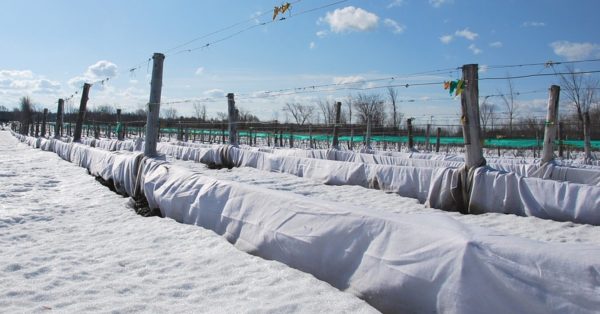
Conservation Tips
Proper preservation of fragrant grapes for the winter will help mindfulness. Preparation includes inspection of landings. The presence of bushes damaged or spoiled as a result of the disease is a weighty argument in favor of an immediate pruning. In winter, the plant spends energy to maintain life. The fewer “juices” go to dead branches, the higher the probability of getting a crop.
Autumn katarovka - a procedure that will strengthen the root system. Spend it as follows:
- A ditch of up to 20 cm is dug around the vineyards;
- remove all roots that are located on the same level with the main root;
- acquire copper sulfate;
- make a solution in a proportion of 2 parts of water to 1 part of copper sulfate;
- for each slice spend up to 50 g of solution;
- the ditch is covered with dry sand.
Winter storage will pass without problems if the soil around the bushes is loosened. The final stage is abundant watering. Each bush takes up to 1 bucket. Water temperature should not be lower than "room".
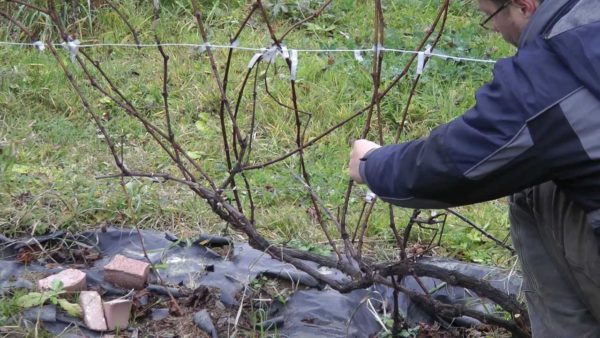
Pruning vines
Bushes with a developed root system are subject to planting. The gardener makes sure that the lowest bud is below, and the highest one is above ground level. The following recommendations will help optimize the storage of grapes in winter:
- after hilling, grapes are covered with earth - up to 6 cm;
- cut the stem by 15 cm - it should have no more than 2 buds;
- in the summer from 2 kidneys processes will form;
- side shoots to be removed;
- leave a few leaves;
- after the leaves fall, up to 4 buds will remain;
- Shelter is carried out after the leaves fall.
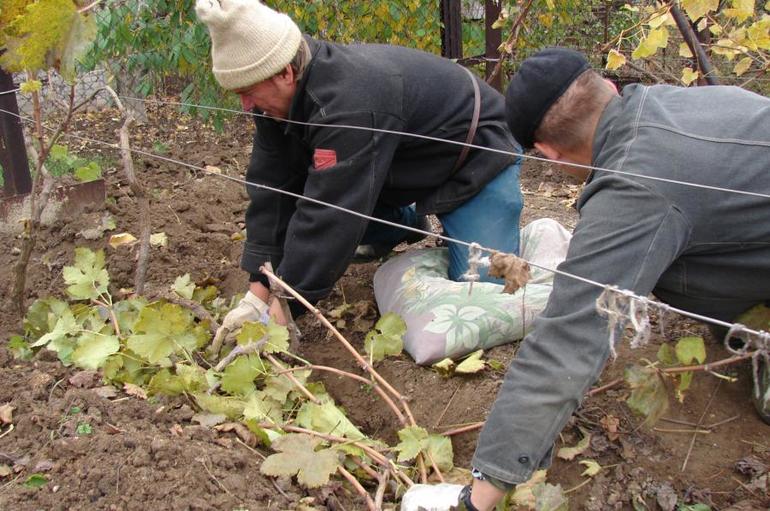 You may be interested in:
You may be interested in:The second year of grape development requires no less attention. Correctly store the vine - this is to trim it to 2 eyes. The remaining shoots are removed. In autumn, up to 4 new shoots will be formed from stored shoots. They are cut into 3 eyes. The following procedure will help speed up the formation of fruiting shoots:
- in each fruiting node, the gardener leaves 1 vine;
- the vine is cut into 8 eyes;
- the spare vine is cut into 2 eyes.
In autumn, fruit shoots are eliminated. The vine is covered.
Vine cutting
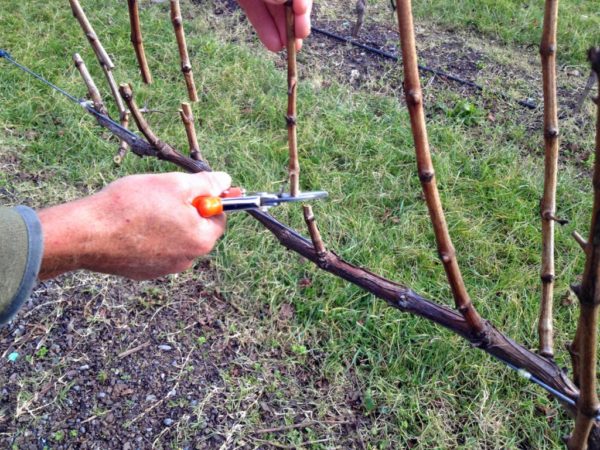
The gardener, after completing the pruning, proceeds to the final stage. Preparation will be effective if it starts in mid-autumn. October is the month in which the level of nutrients in seedlings is greatest. The first rule is that they only work with fruit cuttings. Other branches cannot be used due to their insufficient development. The following diagram will help minimize the likelihood of errors:
- the recommended thickness of the handle is 8 mm;
- a smaller diameter can be taken if the vine is well developed;
- it is forbidden to divide the vine into parts in the internode area;
- division is carried out 3 cm above the internode;
- as a result, all the cut branches will have enough resources to vaccinate;
- transfer winter storage of plants that do not have dark traces in the area of the cut;
- Do not use a pronouncedly curved vine.
The latter fact causes controversy among nerds. There is no unequivocal opinion how even an even vine is better than a curved one in terms of storage. Each gardener decides for himself which option suits him.
Preparatory stage
The length of the cuttings is the key factor that will ensure the safety of seed in the winter. The recommended length of the segment is 1 m. The second significant factor is regular and dosed irrigation. The concentration of water in the vine should not fall below 45%. As soon as gardeners cut seedlings, they are inspected. They must be clearly matured. Even one “raw” branch will lead to a drop in the level of the crop, so it’s worth it to be removed in advance.
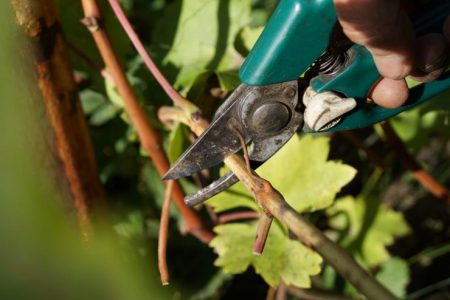 You may be interested in:
You may be interested in: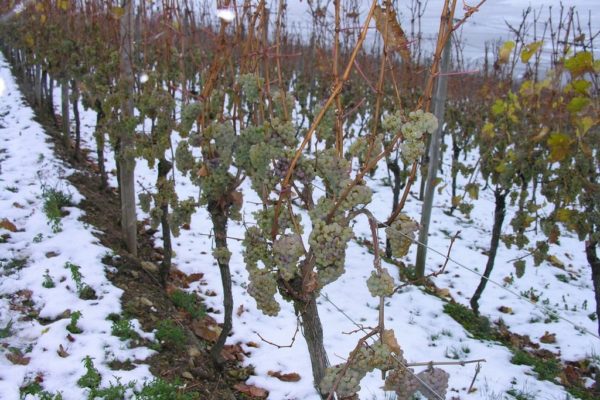
Proper storage
Compliance with several rules will help preserve fragrant grapes in winter for a long time.
| Place of storage of seedlings | ||
| Trench | Fridge | Basement |
| The basement retains a large number of vines in winter. | Preference is given to the chamber where vegetables are stored. If not, then use the bottom shelf of the refrigerator. | If the gardener has a little seed, then he is poured into a suitable box. A layer of clean sand is covered with sand. Its thickness is 10 cm. |
| The depth of the trench is 10 cm greater than the length of the largest cuttings. The walls and bottom of the trench are treated with a solution of lime. | The temperature should not be lower than -5 C. | Prepared Chubuki set so that they do not touch each other. |
| Its bottom is covered with sand. Layer thickness - 10 cm. Fertile soil is poured over the sand. Layer thickness - 10 cm. | The lower part of the seedlings is wrapped with moistened and wrung paper. The next step is the packaging of seedlings in a plastic bag. He is tied with a rope. | Tanks with cuttings should not be located in direct sunlight, otherwise the planting material will quickly burn out. |
| If everything is done according to the rules, then the ground level rises slightly above the trench. If necessary, add nutrient land. | It is forbidden to completely wrap seedlings.Otherwise, the risk of rotting increases significantly. |
Every 4 days they inspect the seedlings. If the earth has become dry, then moisturize.
|
|
Grooves are made next to each elevation. They are necessary for water drainage.
|
The condition of the seedlings is checked once a month. | |
| Once a month they are wiped with cotton wool, which is moistened in a solution of potassium permanganate. | ||
| Once the seed has dried, it is sent back to the refrigerator, pre-packaged as described above. | ||
Cold is the enemy of grapes, so the gardener prepares seedlings for winter in advance. Store it at temperatures up to - 5 degrees. The basement is used in a private house, and the refrigerator is used in the apartment. Before sending for long-term storage, diseased and broken branches are removed. They consume a lot of resources, but do not bear fruit. Regardless of the storage method chosen, the condition of the seedlings is checked every 5-6 days.

 Non-covering winter-hardy grape varieties for Moscow region
Non-covering winter-hardy grape varieties for Moscow region How to keep the vine in winter
How to keep the vine in winter When can I transfer grapes to another place in the fall
When can I transfer grapes to another place in the fall How to cover and prepare grapes for the winter in the suburbs
How to cover and prepare grapes for the winter in the suburbs